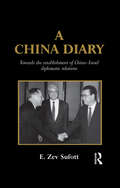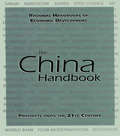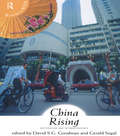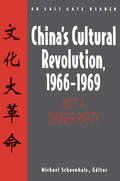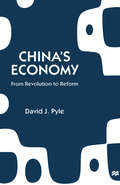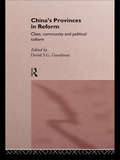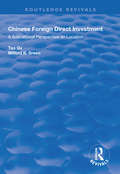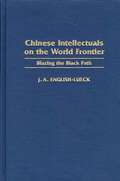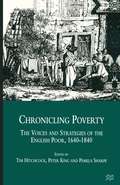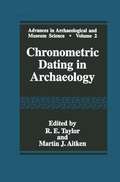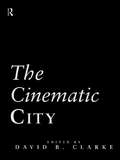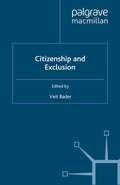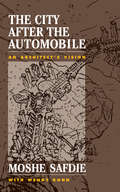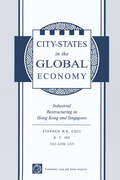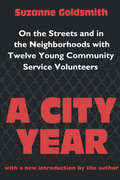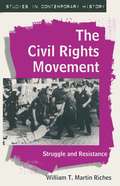- Table View
- List View
A China Diary: Towards the Establishment of China-Israel Diplomatic Relations
by E. Zev SufottFrom his vantage point as the key Israeli in the proceedings, E. Zev Sufott offers a depiction of the clandestine contacts and exchanges between China and Israel which led to the establishment of diplomatic relations.
A China Diary: Towards the Establishment of China-Israel Diplomatic Relations
by E. Zev SufottFrom his vantage point as the key Israeli in the proceedings, E. Zev Sufott offers a depiction of the clandestine contacts and exchanges between China and Israel which led to the establishment of diplomatic relations.
The China Handbook (Regional Handbooks of Economic Development)
by Christopher HudsonFirst Published in 1997. Routledge is an imprint of Taylor & Francis, an informa company.
The China Handbook (Regional Handbooks of Economic Development #Vol. 1)
by Christopher HudsonFirst Published in 1997. Routledge is an imprint of Taylor & Francis, an informa company.
China Rising: Nationalism and Interdependence
by David S.G. Goodman Gerald SegalChina's dramatic economic growth since the 1970s has seemed inexorable. The resulting rise in international profile has provoked a lively argument regarding the fundamental economic and strategic challenges to the rest of the world that China now presents.China Rising examines the extent to which that country's future foreign policy stance may be shaped by its own agendas and constrained through interdependence and interaction with the outside world. In the process it also questions the extent to which the rest of the world can attempt to shape that future to non-Chinese interests with any chance of success.Most debates regarding China's future international position tend to be polarised between those advocating containment and those wishing to see Beijing given a much freer hand. China Rising provides a refreshing alternative to both.
China Rising: Nationalism and Interdependence
by Gerald Segal David GoodmanChina's dramatic economic growth since the 1970s has seemed inexorable. The resulting rise in international profile has provoked a lively argument regarding the fundamental economic and strategic challenges to the rest of the world that China now presents.China Rising examines the extent to which that country's future foreign policy stance may be shaped by its own agendas and constrained through interdependence and interaction with the outside world. In the process it also questions the extent to which the rest of the world can attempt to shape that future to non-Chinese interests with any chance of success.Most debates regarding China's future international position tend to be polarised between those advocating containment and those wishing to see Beijing given a much freer hand. China Rising provides a refreshing alternative to both.
China's Cultural Revolution, 1966-69: Not a Dinner Party
by Michael SchoenhalsMao Zedong launched the "Great Proletarian Cultural Revolution" 30 years ago. This documentary history of the event presents a selection of key primary documents dealing with the Cultural Revolution's massive and bloody assault on China's political and social systems.
China's Cultural Revolution, 1966-69: Not a Dinner Party
by Michael SchoenhalsMao Zedong launched the "Great Proletarian Cultural Revolution" 30 years ago. This documentary history of the event presents a selection of key primary documents dealing with the Cultural Revolution's massive and bloody assault on China's political and social systems.
China’s Economy: From Revolution to Reform
by David J. PyleChina's dramatic economic transformation can only be understood in relation to her modern history. David Pyle reviews the post-1978 reform process in the context of two centuries of Chinese economic, social and political history. Agricultural, industrial and financial reforms and the attraction of foreign trade and direct investment are analysed in detail. The conclusion compares China's gradualist approach with the 'big bang' of Eastern Europe and the former Soviet Union, examining China's prospects and the lessons to be learnt elswhere.
China's Provinces in Reform: Class, Community and Political Culture
by David GoodmanChina is a far larger and more diverse country than many people in the West realise. The provinces that make up the country are considerable social, economic and political systems in their own right. They are comparable in size and complexity to European states.China's Provinces in Reform is concerned with the impact of economic reform and social and politial change within the provinces at the immediate sub-central level of the People's Republic of China. One of the main aims of this book is to question over-generalizations about China's development in the reform era. However, the provincial analysis of social and political change in China also has the potential to reveal even more in a comparative perspective.This is the first volume of a series and covers Guangxi, Hainan, Liaoning, Shandong, Shanghai, Sichuan and Zhejiang. It is part of a project conducted by the Institute for International Studies at the University of Technology, Sydney, that will provide the most thorough and up to date analysis of China's provinces yet published.
China's Provinces in Reform: Class, Community and Political Culture
by David S. G. GoodmanChina is a far larger and more diverse country than many people in the West realise. The provinces that make up the country are considerable social, economic and political systems in their own right. They are comparable in size and complexity to European states.China's Provinces in Reform is concerned with the impact of economic reform and social and politial change within the provinces at the immediate sub-central level of the People's Republic of China. One of the main aims of this book is to question over-generalizations about China's development in the reform era. However, the provincial analysis of social and political change in China also has the potential to reveal even more in a comparative perspective.This is the first volume of a series and covers Guangxi, Hainan, Liaoning, Shandong, Shanghai, Sichuan and Zhejiang. It is part of a project conducted by the Institute for International Studies at the University of Technology, Sydney, that will provide the most thorough and up to date analysis of China's provinces yet published.
Chinese Foreign Direct Investment: A Subnational Perspective on Location (Routledge Revivals)
by Tao Qu Milford B. GreenFirst published in 1997, this volume emerged in the wake of China’s Open Door policy. Qu and Green focus on the spatial aspects of foreign direct investment within China. They aim to locate FDI within a subnational context, with particular reference to the Chinese experience between 1979 and 1993. Issues explored include the philosophy, objectives and process of inducing FDI, the choice of cities and the country of origin effect. Issues explored include the philosophy, objectives and process of inducing FDI, the choice of cities and the country of origin effect.
Chinese Foreign Direct Investment: A Subnational Perspective on Location (Routledge Revivals)
by Tao Qu Milford B. GreenFirst published in 1997, this volume emerged in the wake of China’s Open Door policy. Qu and Green focus on the spatial aspects of foreign direct investment within China. They aim to locate FDI within a subnational context, with particular reference to the Chinese experience between 1979 and 1993. Issues explored include the philosophy, objectives and process of inducing FDI, the choice of cities and the country of origin effect. Issues explored include the philosophy, objectives and process of inducing FDI, the choice of cities and the country of origin effect.
Chinese Intellectuals on the World Frontier: Blazing the Black Path
by J. A. English-LueckThis is the study of the status of intellectuals in the People's Republic of China during and after the events of Tiananmen Square. Currently intellectuals find themselves on the cusp of change as the socialist state monopoly on academia, scientific and technical research is yielding to market pressures. Universities must be, at least partially, self-sustaining. Entrepreneurial niches, outside of state control, are opening for intellectuals as industry privatizes. The entire society has shifted its focus from ideology to material wealth. These dramatic changes have forced choices on China's thought workers. English-Lueck, in conducting over a hundred interviews, highlights the choices and constraints of nonestablishment Chinese intellectuals at the end of the 20th century as they establish a new identity for themselves, and perhaps even for China.
Chronicling Poverty: The Voices and Strategies of the English Poor, 1640-1840
by Tim Hitchcock Pamela Sharpe Peter KingOver the last twenty years more and more historians of the eighteenth and early nineteenth centuries have turned their eyes away from the records of central administration, towards local archives, and the lives of the poor. What they have found is a wealth of sources some of which chronicle the lives, and many of which record the words, of working people. This book will bring together some of the best work based on these sources.
Chronometric Dating in Archaeology (Advances in Archaeological and Museum Science #2)
by Martin J. AitkenSince World War II, there has been tremendous success in the development of new methods for dating artifacts; the so-called `radiocarbon revolution' was only the first such discovery. The increasing accuracy of the various new techniques has brought about major changes in archaeological research strategies. This important new text compiles the work of some of today's most innovative archaeologists who summarize progress in their respective techniques over the last 30 years - with an emphasis on developments of the last five - and the status of current research.
The Cinematic City
by David ClarkeThe Cinematic City offers an innovative and thought-provoking insight into cityscape and screenscape and their inter-connection. Illustrated throughout with movie stills, a diverse selection of films (from 'Bladerunner' to 'Little Caesar'), genres, cities and historical periods are examined by leading names in the field. The key dimensions of film and urban theory are introduced before detailed analysis of the various cinematic forms which relate most significantly to the city. From early cinema and documentary film, to film noir, 'New Wave' and 'postmodern cinema', the contributors provide a wealth of empirical material and illustration whilst drawing on the theoretical insights of contemporary feminism, Benjamin, Baudrillard, Foucault, Lacan, and others. The Cinematic City shows how the city has been undeniably shaped by the cinematic form, and how cinema owes much of its nature to the historical development of urban space. Engaging with current theoretical debates, this is a book that is set to change the way in which we think about both the nature of the city and film. Contributors: Giuliana Bruno, Iain Chambers, Marcus Doel, David Clarke, Anthony Easthope, Elisabeth Mahoney, Will Straw, Stephen Ward, John Gold, James Hay, Rob Lapsley, Frank Krutnik
The Cinematic City
by David B. ClarkeThe Cinematic City offers an innovative and thought-provoking insight into cityscape and screenscape and their inter-connection. Illustrated throughout with movie stills, a diverse selection of films (from 'Bladerunner' to 'Little Caesar'), genres, cities and historical periods are examined by leading names in the field. The key dimensions of film and urban theory are introduced before detailed analysis of the various cinematic forms which relate most significantly to the city. From early cinema and documentary film, to film noir, 'New Wave' and 'postmodern cinema', the contributors provide a wealth of empirical material and illustration whilst drawing on the theoretical insights of contemporary feminism, Benjamin, Baudrillard, Foucault, Lacan, and others. The Cinematic City shows how the city has been undeniably shaped by the cinematic form, and how cinema owes much of its nature to the historical development of urban space. Engaging with current theoretical debates, this is a book that is set to change the way in which we think about both the nature of the city and film. Contributors: Giuliana Bruno, Iain Chambers, Marcus Doel, David Clarke, Anthony Easthope, Elisabeth Mahoney, Will Straw, Stephen Ward, John Gold, James Hay, Rob Lapsley, Frank Krutnik
Citizenship and Exclusion
by Veit BaderCitizenship implies exclusion of non-members. Migrations, processes and policies of first admission and incorporation of ethnically and culturally diverse newcomers are among the most hotly contested political issues, especially in a world of gross inequalities. This comparative and interdisciplinary collection sees distinguished moral and political philosophers, historians, sociologists, anthropologists and political scientists from America, Australia and Europe criticize existing institutions and increasingly restrictive policies and look for alternatives more in line with principles and constitutions of liberal democratic welfare states.
The City After The Automobile: An Architect's Vision
by Moshe SafdieIn an age of virtual offices, urban flight, and planned gated communities, are cities becoming obsolete? In this passionate manifesto, Moshe Safdie argues that as crucibles for creative, social, and political interaction, vital cities are an organic and necessary part of human civilization. If we are to rescue them from dispersal and decay, we must first revise our definition of what constitutes a city.Unlike many who believe that we must choose between cities and suburbs, between mass transit and highways, between monolithic highrises and panoramic vistas, Safdie envisions a way to have it all. Effortless mobility throughout a region of diverse centers, residential communities, and natural open spaces is the key to restoring the rich public life that cities once provided while honoring our profound desire for privacy, flexibility, and freedom. With innovations such as transportation nodes, elevated moving sidewalks, public utility cars, and buildings designed to maximize daylight, views, and personal interaction, Safdie's proposal challenges us all to create a more satisfying and humanistic environment.
The City After The Automobile: An Architect's Vision
by Moshe SafdieIn an age of virtual offices, urban flight, and planned gated communities, are cities becoming obsolete? In this passionate manifesto, Moshe Safdie argues that as crucibles for creative, social, and political interaction, vital cities are an organic and necessary part of human civilization. If we are to rescue them from dispersal and decay, we must first revise our definition of what constitutes a city.Unlike many who believe that we must choose between cities and suburbs, between mass transit and highways, between monolithic highrises and panoramic vistas, Safdie envisions a way to have it all. Effortless mobility throughout a region of diverse centers, residential communities, and natural open spaces is the key to restoring the rich public life that cities once provided while honoring our profound desire for privacy, flexibility, and freedom. With innovations such as transportation nodes, elevated moving sidewalks, public utility cars, and buildings designed to maximize daylight, views, and personal interaction, Safdie's proposal challenges us all to create a more satisfying and humanistic environment.
City States In The Global Economy: Industrial Restructuring In Hong Kong And Singapore (Transitions: Asia And Asian America Ser.)
by Stephen Wing-kai ChiuThis is the first serious comparative study of two dynamic Asian city-states that are emerging as key regional?indeed global?cities. Providing both historical comparisons and analyses of contemporary issues, the authors consider the patterns, strategies, and consequences of industrial restructuring. They build their analysis around the interrelationships of four institutional spheres: the global economy, the state, the financial system, and the labor market. This leads to a unique emphasis on the distinctiveness of individual NICs, as opposed to much of the literature in the field, which tends to group these Asian dragons together as a single, undifferentiated case.The book addresses three basic sets of questions tied to industrial restructuring in Hong Kong and Singapore: First, what are the basic patterns of restructuring in the two economies? What corporate strategies have manufacturers used to restructure their operations? Are Hong Kong and Singapore diverging or utilizing the same restructuring strategies? Second, how should the process of restructuring in the two economies and the concomitant similarities or divergencies be explained? Third, what are the consequences of the restructuring process for the two economies? How are these processes shaped by the shared histories of Hong Kong and Singapore as colonial port cities, their current status as NICs ?squeezed? between industrialized western societies and the Third World, and their role as important regional cities in East and Southeast Asia?
A City Year: On the Streets and in the Neighbourhoods with Twelve Young Community Volunteers
by Suzanne GoldsmithIn his inaugural address in 1993, President Clinton said: "I challenge a new generation of young Americans to a season of service to act on your idealism by helping troubled children, keeping company with those in need, reconnecting our torn communities." In the fall of 1990, Suzanne Goldsmith had signed on for her own "season of service" with City Year, the widely praised, Boston-based community service program frequently endorsed by political figures as a model for the nation. 'A City Year' is the story of Goldsmith's experience, an honest and gritty account of the triumphs and setbacks faced by an idealistic and experimental social program in its infancy. Together with a diverse team of young men and women--including a Burmese immigrant, a white prep-school graduate, a foster child, an ex-convict, and a black middle-class college student--Goldsmith helped renovate a building for the homeless, tutored school children, reclaimed a community garden from drug dealers, and organized a community street-cleaning day. The year Included backbreaking but gratifying work, the sense of family that comes from collaborative labor, and the potential strength of diversity. 'A City Year' is both the story of an uphill battle in urban America and an uplifting recipe for social change. As the AmeriCorps national service program dangles in the political wind on Capitol Hill, this book offers a true glimpse of what a "season of service" really means. It is a fascinating account for sociologists and all those with an interest in community service and youth.
A City Year: On the Streets and in the Neighbourhoods with Twelve Young Community Volunteers
by Suzanne GoldsmithIn his inaugural address in 1993, President Clinton said: "I challenge a new generation of young Americans to a season of service to act on your idealism by helping troubled children, keeping company with those in need, reconnecting our torn communities." In the fall of 1990, Suzanne Goldsmith had signed on for her own "season of service" with City Year, the widely praised, Boston-based community service program frequently endorsed by political figures as a model for the nation. 'A City Year' is the story of Goldsmith's experience, an honest and gritty account of the triumphs and setbacks faced by an idealistic and experimental social program in its infancy. Together with a diverse team of young men and women--including a Burmese immigrant, a white prep-school graduate, a foster child, an ex-convict, and a black middle-class college student--Goldsmith helped renovate a building for the homeless, tutored school children, reclaimed a community garden from drug dealers, and organized a community street-cleaning day. The year Included backbreaking but gratifying work, the sense of family that comes from collaborative labor, and the potential strength of diversity. 'A City Year' is both the story of an uphill battle in urban America and an uplifting recipe for social change. As the AmeriCorps national service program dangles in the political wind on Capitol Hill, this book offers a true glimpse of what a "season of service" really means. It is a fascinating account for sociologists and all those with an interest in community service and youth.
The Civil Rights Movement: Struggle and Resistance (Studies in Contemporary History)
by William T. RichesHow did a relatively powerless minority bring down the whole system of racial segregation in America within a single generation? The civil rights movement led to the dismantlement of institutionalised racism and transformed American society. William Riches chronicles the growth of the mass movement from its origins in less well documented battles for civil liberties, through to its eventual success with the destruction of a de jure segregated society.
